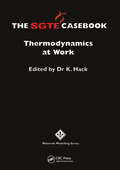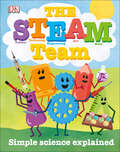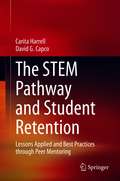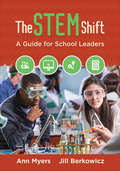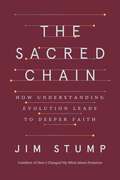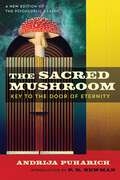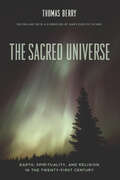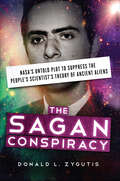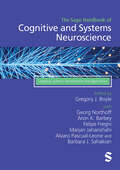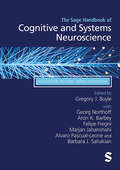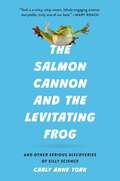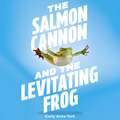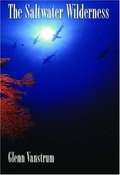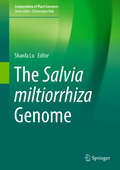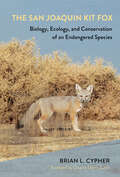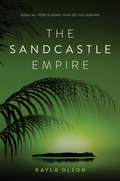- Table View
- List View
The SGTE Casebook: Thermodynamics at Work
by K. HackThe Scientific Group Thermodata Europe (SGTE) is a consortium involved in the development and application of thermodynamic databanks for materials such as metals. Building on SGTE research, the second edition of this standard reference presents thermodynamic calculations as the basic tools in developing and optimizing various materials and processes. The SGTE Casebook: Thermodynamics at Work, Second Edition shows how this data can optimize the production and quality of steel and other alloys. The book explores phases stable at equilibrium as well as their amounts and compositions, and provides information about the degree of instability of the phases not present at equilibrium
The STEAM Revolution: Transdisciplinary Approaches to Science, Technology, Engineering, Arts, Humanities and Mathematics
by Charles Travis Armida de la GarzaThis volume is dedicated to collaborative research across STEM disciplines, the arts and humanities. It includes six sections, framed from a global perspective and exhibits contributions from key experts in the field, emerging scholarly voices, and STEAM practitioners. The added value of STEAM projects in research is highlighted in the first section of this book. Ranging from the spatial, medical and environmental humanities to heritage science, this section discusses the course and paths STEAM projects may evolve to in the near future. The second section features reflective essays by scientists and artists on the development of their research, their professional growth and personal learning experiences that the art/science collaborations have afforded their work and careers. Sections III and IV provides practical guidance and advice on facilitating STEAM teams and describe successful collaborative projects. By presenting the objectives and outcomes of relevant research, the chapters in these sections discuss the various steps taken by different teams to achieve project fruition. Paying particular attention to barriers inhibiting STEAM collaboration, these sections also explore the ways in which research teams were able to work effectively. The fifth section presents a review of policy issues and the potential impacts of STEAM research for administrators, funders and policy makers. In its pursuit for balance and inclusion, the volume concludes with a critical reflection on STEAM that argues a different perspective and will prove food for thought to readers.
The STEAM Team: Simple Science Explained
by Lisa BurkeThe zany characters of The STEAM Team will guide kids through this engaging, fact packed kid's book all about the key subjects - science, technology, engineering, art, and math.An excellent introduction for children ages 5-7 to understanding these concepts, The STEAM Team is a colorful, well-presented education book for children that will get your little ones crazy for STEAM subjects!This brightly illustrated science book for kids breaks down STEAM subjects and complicated ideas into fun and easily understandable pieces. Join The STEAM Team to unravel the mysteries of science for kids - find out how robots work, what a food chain is, where lightning comes from, and much more!The STEAM Team characters (Science, Technology, Engineering, Art, and Math) guide the reader through the book and are always on hand with tips, fun facts, and simple explanations. The ingeniousness of The STEAM Team is the characters - keeping little ones engaged and engrossed throughout. In these pages the Team cover living things, the human body, space, physics, geography, math, engineering, and chemistry. This book is a fantastic first children's book for kids starting to learn STEAM subjects in school, or who are developing an insatiable interest in the world around them.Meet The Steam Team!The STEAM Team is made up of five cool characters (subjects) that work together to show you how the world works. Science is all about asking questions and discovering the answers to explain how things work. Technology uses science to create new machines and effective ways of doing things. Engineering is all about finding and designing solutions to problems - using science, technology, and math. Art is all about using your imagination and style to create brilliant new things. Math is about numbers, patterns, and problem solving. They are the perfect team to teach you all about STEAM - Science, Technology, Engineering, Art, and Math!Find out what science is, why it is so important, and how it relates to the world around you. Discover how machines work, what a food web is, why boats float, where lightning comes from, and much much more!From Amphibians to Darwin to the Internet, this book is full of interesting STEAM facts covering: - The Universe- Plants- Robots- The human body- Measuring- Climate Change- And so much more!If you are looking to add more books to your collection that answer the questions about the world, give Ask A Scientist a try for the little "why?" askers in your life.
The STEM Night Disaster (Kate the Chemist)
by Kate BiberdorfThe third installment of the Kate the Chemist series that shows kids that everyone can be a scientist!Kate's school is having their first-ever STEM Night and the prizes are incredible! Kate is determined to win and comes up with the perfect experiment. But as she and her best friend, Birdie, start preparing, they find that Kate's project keeps getting messed up. Will Kate be able to use her science know-how to find out who is behind the STEM night sabotage? And will she fix her project before it's too late?Praise for Kate the Chemist: Dragons vs. Unicorns:"Proves that science and fun go together like molecules in a polymer."--School Library Journal"It's a great introduction to the basics of Chemistry that is readily accessible to a variety of ages . . . . The way the everyday chemistry is blended in is done seamlessly, and has [me and my ten-year-old son] noticing how we are all doing a little bit of science everyday." --GeekMom.com
The STEM Pathway and Student Retention: Lessons Applied and Best Practices through Peer Mentoring
by David G. Capco Carita HarrellThis work introduces methods that aid in freshman retention (in the transition from high school and to remain in the university of origin) and orient them towards a successful career in science. Specific examples of successful approaches are given as well as detailed plans for how to engage these students. Pitfalls as well as success are described. In addition this work provides a detailed description of how to develop the students into a cohort that exhibits comradery. Three types of cohort form, those within the freshman class, those among the upperclassmen and those between the freshmen and upperclassmen. The program works because the social reality is that the peer mentor has a better repertoire with the first semester freshmen than the faculty or staff and assists with student success. Factors such as financial aid, policy, and support systems influence student success. In the sciences, students often struggle with the content and adjusting to the college experience. Research states that a mentorship program supports retention as well as enhances the student experience during college. This program creates a cohort group among the upperclassmen mentors and freshmen and provides leadership development for all involved.
The STEM Shift: A Guide for School Leaders
by Ann P. Myers Jill BerkowiczAll you need to make the shift to STEM a reality! Now more than ever, educational leaders are encouraged to implement STEM as the foundation for preparing students with the 21st century skills required for college and career readiness. This resource makes the process of shifting to a comprehensive, integrated STEM school or district within reach! Invaluable case studies featuring current STEM pioneers from across the country model how successful, STEM-centered learning takes place. You’ll find process-specific best practices and strategies to help you: Understand, create, and lead the STEM change process Transform existing school programs Prepare the school community for STEM and plan for STEM integration Integrate 21st Century Skills, the arts, and humanities Create essential partnerships with business and higher education Includes step-by-step checklists and visual mapping guides for successfully navigating the STEM change process. Use this groundbreaking resource to systematically implement coherent and integrated STEM instruction that transforms learning and prepares students for the global economy! Video and web content also available at http://bit.ly/TheSTEMShift. "Finally! A great book that clearly explains what STEM education is, why we need it, and how to do it well. A must-read for all educators, parents, and policymakers." Tony Wagner, author of The Global Achievement Gap and Creating Innovators "Reading Jill and Ann′s column in Education Week has been a critical part of my weekly reading since they′ve begun writing it. I′ve learned a lot from those short snippets, and now it′s exciting to see their expanded thoughts in The Stem Shift. You can′t go wrong by reading anything they write!" Larry Ferlazzo, High school teacher and Ed Week columnist
The STEM Shift: A Guide for School Leaders
by Ann P. Myers Jill BerkowiczAll you need to make the shift to STEM a reality! Now more than ever, educational leaders are encouraged to implement STEM as the foundation for preparing students with the 21st century skills required for college and career readiness. This resource makes the process of shifting to a comprehensive, integrated STEM school or district within reach! Invaluable case studies featuring current STEM pioneers from across the country model how successful, STEM-centered learning takes place. You’ll find process-specific best practices and strategies to help you: Understand, create, and lead the STEM change process Transform existing school programs Prepare the school community for STEM and plan for STEM integration Integrate 21st Century Skills, the arts, and humanities Create essential partnerships with business and higher education Includes step-by-step checklists and visual mapping guides for successfully navigating the STEM change process. Use this groundbreaking resource to systematically implement coherent and integrated STEM instruction that transforms learning and prepares students for the global economy! Video and web content also available at http://bit.ly/TheSTEMShift. "Finally! A great book that clearly explains what STEM education is, why we need it, and how to do it well. A must-read for all educators, parents, and policymakers." Tony Wagner, author of The Global Achievement Gap and Creating Innovators "Reading Jill and Ann′s column in Education Week has been a critical part of my weekly reading since they′ve begun writing it. I′ve learned a lot from those short snippets, and now it′s exciting to see their expanded thoughts in The Stem Shift. You can′t go wrong by reading anything they write!" Larry Ferlazzo, High school teacher and Ed Week columnist
The Sacred Chain: How Understanding Evolution Leads to Deeper Faith
by Jim StumpA thought-provoking and eye-opening work by Jim Stump, Vice President at BioLogos and host of the Language of God podcast, offering a compelling argument about how evolution does not have to be at odds with faith, but can actually enrich and deepen it.In this moving and deeply thoughtful book, Jim Stump takes readers with him on his journey to understanding evolution and reconciling it with his faith. The Sacred Chain draws on philosophy, theology, and the latest scientific research to tackle some of the biggest questions facing humanity and people of faith today, such as:How can we hold the Bible as a sacred text and yet reconcile modern science with it?By condensing noteworthy events in the history of our universe into one calendar week, what can we learn about God’s creative process and priorities, and where humans fit in?If humans are created in the image of God, what does evolution have to teach us about our species and our place in creation?What about the soul? How can we understand our transcendent qualities if the human body is the product of evolution?How does evolutionary science help us understand how God might use pain and suffering for important and good purposes?Does it have to be one or the other—science or religion—or is there a third way, one that not only preserves faith in the face of modern science, but leads to a stronger, more relevant, and more authentic faith?Deeply researched and a delight to read, The Sacred Chain provides clarity in our uncertain times, revealing a bigger picture of our world and our place within it. It is a panorama consistent with the scientific findings about who we are and where we come from that can actually bolster our faith as it engages our curiosity about ourselves, our universe, and the nature of existence itself.
The Sacred Mushroom: Key to the Door of Eternity
by Andrija Puharich• Shares the author&’s research on extrasensory perception (ESP) and the psychic effects of hallucinogenic mushrooms• Describes ancient Egyptian spiritual practices centered on Amanita muscaria (fly agaric) mushrooms• Details the author&’s research work with R. Gordon Wasson and his experiments with Aldous Huxley and famed psychic Peter HurkosIn 1954, neurologist Andrija Puharich, M.D., receives a call from a wealthy supporter of his lab about an unusual subject worthy of further research: Harry Stone, a young sculptor with unusually acute extrasensory perception. When handed an ancient Egyptian artifact, Harry had fallen into a deep trance, drawing hieroglyphic symbols, including mushrooms, and using ancient Egyptian phrases to describe a drug that can enhance psychic abilities.Intrigued, Dr. Puharich studies Harry&’s trance-induced statements and discovers that they are clearly describing ancient spiritual practices involving Amanita muscaria (fly agaric) mushrooms. He begins direct investigations with Harry at his lab in Maine, learning more about the use and preparation of the sacred mushroom as well as about astral travel and past lives. Dr. Puharich shares his research with ethnomycologist R. Gordon Wasson, who is about to travel to Mexico on a CIA-funded research trip, and the two researchers agree to test telepathic communications between the lab in Maine and a Mexican curandero. The results of the psychic experiment lead Puharich to discover Amanita muscaria growing in the wild near his research facility.Now with a supply of the sacred mushroom, Dr. Puharich begins to study its psychic and visionary potential and the veracity of Harry Stone&’s channeled Egyptian statements. He studies the effects of Amanita muscaria not only on Harry, but also on famed psychic Peter Hurkos and other visitors to his lab, including Aldous Huxley. This book reveals all the details of that story in this new edition of the psychedelic classic. It also includes an in-depth introduction by psychedelic historian P. D. Newman.
The Sacred Promise
by John Edward Gary E. SchwartzSacred Promise brings us into the laboratory of scientist Dr. Gary Schwartz, where he establishes the existence of Spirit by its own Willful Intent--a proof of concept for deceased spirits. The author takes readers on a personal journey into the world of angels and spirits and reveals their existence and desire to help. Dr. Schwartz candidly discusses the challenges as well as the rewards of connecting with Spirit. He poses several important questions. What if our feelings of emptiness, loneliness, hopelessness, and meaninglessness are actually fostered by our belief in a "spiritless" Universe? What if our physical hunger is symptomatic of a greater spiritual hunger? What if Spirit is actually all around us, ready to fill us with energy, hope, and direction, if we are ready to ingest it? What if Spirit is like air and water, readily available for us to draw within; that is, if we choose to seek it? Sacred Promise shows how we can attune ourselves and receive this guidance from Spirit, which is all scientifically documented by Dr. Schwartz experiments and research. Prepare to suspend your beliefs about Spirit.
The Sacred Universe: Earth, Spirituality, and Religion in the Twenty-First Century
by Thomas BerryA leading scholar, cultural historian, and Catholic priest who spent more than fifty years writing about our engagement with the Earth, Thomas Berry possessed prophetic insight into the rampant destruction of ecosystems and the extinction of species. In this book he makes a persuasive case for an interreligious dialogue that can better confront the environmental problems of the twenty-first century. These erudite and keenly sympathetic essays represent Berry's best work, covering such issues as human beings' modern alienation from nature and the possibilities of future, regenerative forms of religious experience. Asking that we create a new story of the universe and the emergence of the Earth within it, Berry resituates the human spirit within a sacred totality.
The Saffron Genome (Compendium of Plant Genomes)
by Chittaranjan Kole Jyoti Vakhlu Sheetal Ambardar Seyed Alireza SalamiThis book is about Saffron (Crocus sativus L.) that is the most expensive spice in the world. Though there are other books on saffron but none of them has comprehensive information on saffron genome, transcriptome, proteome, metabolome and microbiome. The book has been divided into five sections and 17 chapters that cover all the areas related to its cultivation, market & economy, genomics, transcriptomics, proteomics, metabolomics, tissue culture, microbiomics, metagenomics etc. In addition a chapter on molecular markers and their use in molecular genetic mapping in saffron that lacks genetic diversity as a sterile plant paves a way for selection of elite varieties based on the epigenetic variability. A section on in-vitro propagation elaborates on the corm production under controlled conditions. In summary this book encompasses most of the information available on this golden spice
The Sagan Conspiracy: NASA's Untold Plot to Suppress the People's Scientist's Theory of Ancient Aliens
by Donald L. ZygutisMainstream SETI scientists and ancient alien theorists don’t agree on much, but one opinion they share is that the undisputed authority on the possibility of alien existence was the late Carl Sagan (1934—1996), whose voluminous writings on the subject have had a profound influence on ETI research.But how many Carl Sagan fans know that while the renowned scientist was at Stanford University, he produced a controversial paper, funded by a NASA research grant, that concludes ancient alien intervention may have sparked human civilization? Author Donald Zygutis lays out a compelling case that points to a cover-up by the Pentagon and NASA, who may have buried it soon after it was written. How significant is the Stanford Paper? The answer may lie in another question: How would a science-backed theory and search strategy to guide the discovery of alien artifacts among our own ancient civilizations impact the worldwide institutions of government, religion, and culture?Recently rediscovered by the author, Sagan’s lost Stanford paper is the central theme of The Sagan Conspiracy. Groundbreaking research and paradigm-changing material challenges conventional thinking about the People’s Scientist—and maybe even the origins of human society. Sagan even conceived of the likelihood that the ancient Sumerian civilization had been visited and influenced by beings from other worlds as evidenced by ancient manuscripts, among other artifacts.As we celebrate the 20-year anniversary of Carl’s death, The Sagan Conspiracy is sure to fundamentally alter how the world thinks about extraterrestrials.
The Sage Handbook of Cognitive and Systems Neuroscience: Cognitive Systems, Development and Applications
by Alvaro Pascual-Leone Georg Northoff Barbara J. Sahakian Felipe Fregni Marjan Jahanshahi Aron K. Barbey Gregory J. BoyleCognitive neuroscience is the interdisciplinary study of how cognitive and intellectual functions are processed and represented within the brain, which is critical to building understanding of core psychological and behavioural processes such as learning, memory, behaviour, perception, and consciousness. Understanding these processes not only offers relevant fundamental insights into brain-behavioural relations, but may also lead to actionable knowledge that can be applied in the clinical treatment of patients with various brain-related disabilities. This Handbook examines complex cognitive systems through the lens of neuroscience, as well as providing an overview of development and applications within cognitive and systems neuroscience research and beyond. Containing 35 original, state of the art contributions from leading experts in the field, this Handbook is essential reading for researchers and students of cognitive psychology, as well as scholars across the fields of neuroscientific, behavioural and health sciences. Part 1: Attention, Learning and Memory Part 2: Language and Communication Part 3: Emotion and Motivation Part 4: Social Cognition Part 5: Cognitive Control and Decision Making Part 6: Intelligence
The Sage Handbook of Cognitive and Systems Neuroscience: Cognitive Systems, Development and Applications
by Alvaro Pascual-Leone Georg Northoff Barbara J. Sahakian Felipe Fregni Marjan Jahanshahi Aron K. Barbey Gregory J. BoyleCognitive neuroscience is the interdisciplinary study of how cognitive and intellectual functions are processed and represented within the brain, which is critical to building understanding of core psychological and behavioural processes such as learning, memory, behaviour, perception, and consciousness. Understanding these processes not only offers relevant fundamental insights into brain-behavioural relations, but may also lead to actionable knowledge that can be applied in the clinical treatment of patients with various brain-related disabilities. This Handbook examines complex cognitive systems through the lens of neuroscience, as well as providing an overview of development and applications within cognitive and systems neuroscience research and beyond. Containing 35 original, state of the art contributions from leading experts in the field, this Handbook is essential reading for researchers and students of cognitive psychology, as well as scholars across the fields of neuroscientific, behavioural and health sciences. Part 1: Attention, Learning and Memory Part 2: Language and Communication Part 3: Emotion and Motivation Part 4: Social Cognition Part 5: Cognitive Control and Decision Making Part 6: Intelligence
The Sage Handbook of Cognitive and Systems Neuroscience: Neuroscientific Principles, Systems and Methods
by Alvaro Pascual-Leone Georg Northoff Barbara J. Sahakian Felipe Fregni Marjan Jahanshahi Aron K. Barbey Gregory J. BoyleCognitive neuroscience is the interdisciplinary study of how cognitive and intellectual functions are processed and represented within the brain, which is critical to building understanding of core psychological and behavioural processes such as learning, memory, behaviour, perception, and consciousness. Understanding these processes not only offers relevant fundamental insights into brain-behavioural relations, but may also lead to actionable knowledge that can be applied in the clinical treatment of patients with various brain-related disabilities. This Handbook focusses on the foundational principles, methods, and underlying systems in cognitive and systems neuroscience, as well as examining cutting-edge methodological advances and innovations. Containing 34 original, state of the art contributions from leading experts in the field, this Handbook is essential reading for researchers and students of cognitive psychology, as well as scholars across the fields of neuroscientific, behavioural and health sciences. Part 1: Background Considerations Part 2: Neuroscientific Substrates and Principles Part 3: Neuroanatomical Brain Systems Part 4: Neural Dynamics and Processes Part 5: Sensory-Perceptual Systems and Cognition Part 6: Methodological Advances
The Sage Handbook of Cognitive and Systems Neuroscience: Neuroscientific Principles, Systems and Methods
by Alvaro Pascual-Leone Georg Northoff Barbara J. Sahakian Felipe Fregni Marjan Jahanshahi Aron K. Barbey Gregory J. BoyleCognitive neuroscience is the interdisciplinary study of how cognitive and intellectual functions are processed and represented within the brain, which is critical to building understanding of core psychological and behavioural processes such as learning, memory, behaviour, perception, and consciousness. Understanding these processes not only offers relevant fundamental insights into brain-behavioural relations, but may also lead to actionable knowledge that can be applied in the clinical treatment of patients with various brain-related disabilities. This Handbook focusses on the foundational principles, methods, and underlying systems in cognitive and systems neuroscience, as well as examining cutting-edge methodological advances and innovations. Containing 34 original, state of the art contributions from leading experts in the field, this Handbook is essential reading for researchers and students of cognitive psychology, as well as scholars across the fields of neuroscientific, behavioural and health sciences. Part 1: Background Considerations Part 2: Neuroscientific Substrates and Principles Part 3: Neuroanatomical Brain Systems Part 4: Neural Dynamics and Processes Part 5: Sensory-Perceptual Systems and Cognition Part 6: Methodological Advances
The Salmon Cannon and the Levitating Frog: And Other Serious Discoveries of Silly Science
by Carly Anne YorkA brilliant new voice in science writing—"witty, whip-smart, truly one of our best" (Mary Roach)—shows why playfulness and curiosity are the key to science Why would anyone research how elephants pee? Or study worms who tie themselves into a communal knot? Or quantify the squishability of a cockroach? It all sounds pointless, silly, or even disgusting. Maybe it is. But in The Salmon Cannon and the Levitating Frog, Carly Anne York shows how unappreciated, overlooked, and simply curiosity-driven science has led to breakthroughs big and small. Got wind power? You might have humpback whales to thank. Know anything about particle physics? Turns out there is a ferret close to the heart of it all. And if you want to keep salmon around, be thankful for that cannon! The research itself can seem bizarre. But it drives our economy. And what&’s more, this stuff is simply cool. York invites readers to appreciate the often unpredictable journey of scientific exploration, highlighting that the heart of science lies in the relentless pursuit of knowledge for its own sake. Emphasizing the hard work of the people behind the discoveries, this is an accessible, story-driven book that shows how important and exciting it is to simply let curiosity run wild.
The Salmon Cannon and the Levitating Frog: And Other Serious Discoveries of Silly Science
by Carly Anne YorkA playful examination of how science's silliest research leads to crucial breakthroughs and enduring insights.Why would anyone research how elephants pee? Or study worms who tie themselves into a communal knot? Or quantify the squishability of a cockroach? It all sounds pointless, silly, or even disgusting.Maybe it is. But in The Salmon Cannon and the Levitating Frog, Carly Anne York shows how unappreciated, overlooked, and simply curiosity-driven science has led to breakthroughs big and small. Got wind power? You might have humpback whales to thank. Know anything about particle physics? Turns out there is a ferret close to the heart of it all. And if you want to keep salmon around, be thankful for that cannon! The research itself can seem bizarre. But it drives our economy. And what's more, this stuff is simply cool.York invites readers to appreciate the often unpredictable journey of scientific exploration, highlighting that the heart of science lies in the relentless pursuit of knowledge for its own sake. Emphasizing the hard work of the people behind the discoveries, this is an accessible, story-driven book that shows how important and exciting it is to simply let curiosity run wild.
The Salmon Cannon and the Levitating Frog: And Other Serious Discoveries of Silly Science
by Carly Anne YorkA playful examination of how science's silliest research leads to crucial breakthroughs and enduring insights.Why would anyone research how elephants pee? Or study worms who tie themselves into a communal knot? Or quantify the squishability of a cockroach? It all sounds pointless, silly, or even disgusting.Maybe it is. But in The Salmon Cannon and the Levitating Frog, Carly Anne York shows how unappreciated, overlooked, and simply curiosity-driven science has led to breakthroughs big and small. Got wind power? You might have humpback whales to thank. Know anything about particle physics? Turns out there is a ferret close to the heart of it all. And if you want to keep salmon around, be thankful for that cannon! The research itself can seem bizarre. But it drives our economy. And what's more, this stuff is simply cool.York invites readers to appreciate the often unpredictable journey of scientific exploration, highlighting that the heart of science lies in the relentless pursuit of knowledge for its own sake. Emphasizing the hard work of the people behind the discoveries, this is an accessible, story-driven book that shows how important and exciting it is to simply let curiosity run wild.
The Saltwater Wilderness
by Glenn S. VanstrumThis book plunges the reader into the heart of the sea. It provides an account of one photojournalist's experience studying marine natural history and ecology. Illustrated with black and white photography, and annotated with references to classic marine literature, this book takes the reader from California to New Guinea, Fiji, Palau, and Tonga, to the Caribbean, to Alaska, and back again. Along the way, a quest to shed light on marine limits, symbiosis, and biogeography ties the adventures together. It will appeal to anyone who snokels, swims, scuba dives, surfs, studies marine biology, or loves the sea.
The Salvia miltiorrhiza Genome (Compendium of Plant Genomes)
by Shanfa LuThis is the first book on the genome of Salvia miltiorrhiza, summarizing the research advances in the molecular mapping, whole genome sequencing, chloroplast and mitochondria genomes, epigenetics, transcriptomics and functional genomics of this emerging model plant with great economic and medicinal value. It also describes its distribution, taxonomy and morphology and provides useful information on its cultivation and breeding. Further, it highlights the biosynthetic pathways of tanshinones and phenolic acids – two main classes of bioactive components produced in this plant species – and reviews and discusses the technology of hairy root induction, tissue culture and genetic transformation of S. miltiorrhiza.The book is a valuable resource for students, teachers and researchers in academia and industry interested in medicinal plants and pharmacy.
The San Joaquin Kit Fox: Biology, Ecology, and Conservation of an Endangered Species
by Brian L. CypherThe San Joaquin Kit Fox introduces readers to a small wild canid that occupies a prominent position in ongoing conservation battles. Native to central California, where land is in high demand for development purposes, the San Joaquin kit fox population has been significantly impacted by profound habitat loss. The species remains on the original US endangered species list issued in 1966, with dim prospects for recovery.To guide the work of researchers and conservationists, Brian L. Cypher synthesizes the biological and ecological data collected to date on this species and documents both historical and contemporary efforts to protect it. He details the species' evolutionary and taxonomic history, distribution and habitat preferences, mortality sources, and more. In doing so, he draws out the ever-changing relationship between San Joaquin kit foxes, people, and land use. Richly illustrated and accessible, The San Joaquin Kit Fox is a necessary reference for students, researchers, and conservationists looking to better understand this charismatic creature and others like it in order to better secure the futures of these species.
The Sandalwood Genome (Compendium of Plant Genomes)
by Chittaranjan Kole Malali Gowda H. B. MaheshThis book is the first comprehensive compilation describing the importance of sandalwood in national and international markets, genetic resources, molecular markers, whole genome sequencing, and pathway genes involved in oil biosynthesis, aroma and fragrance. Application of various “omics” approaches in delineating genome architecture and annotation of genes is highlighted. This book comprises 10 chapters covered over 200 pages authored by the researchers involved in sandalwood genomics. The sandalwood, Santalum album is known for its unique fragrance and finest wood available for carving. Also, sandalwood is intertwined with Indian culture and it is the second most valuable and expensive tree in the world.
The Sandcastle Empire
by Kayla OlsonBefore the war, Eden’s life was easy. Then the revolution happened, and everything changed.Now a powerful group called the Wolfpack controls the earth and its resources. And even though Eden has lost everything to them, she refuses to die by their hands. She knows the coordinates to the only neutral ground left in the world, a place called Sanctuary Island, and she is desperate to escape to its shores.Eden finally reaches the island and meets others resistant to the Wolves. But the solace is short-lived when one of Eden’s new friends goes missing. Braving the jungle in search of their lost ally, they quickly discover Sanctuary is filled with lethal traps and an enemy they never expected.This island might be deadlier than the world Eden left behind, but surviving it is the only thing that stands between her and freedom.
